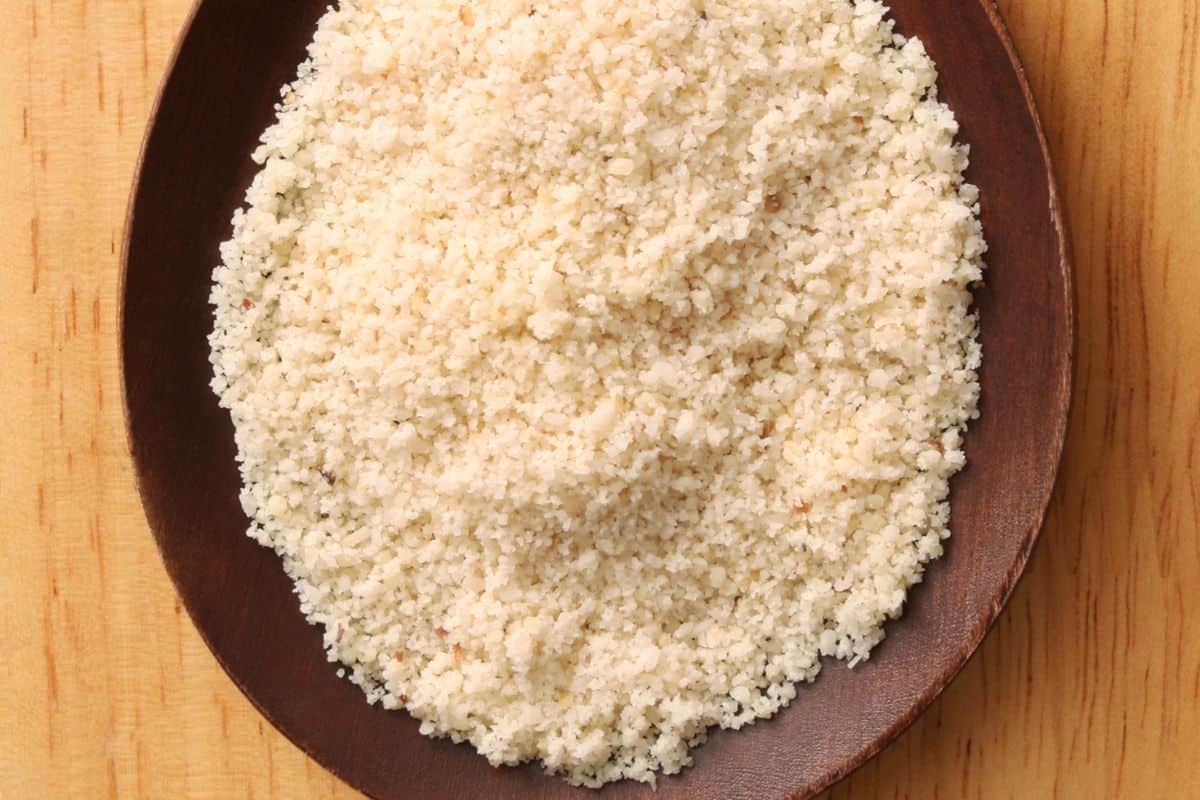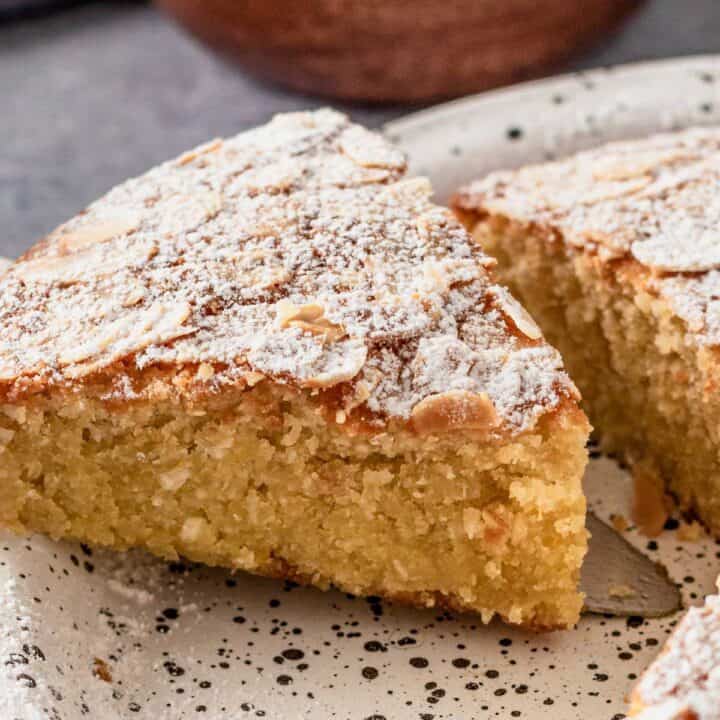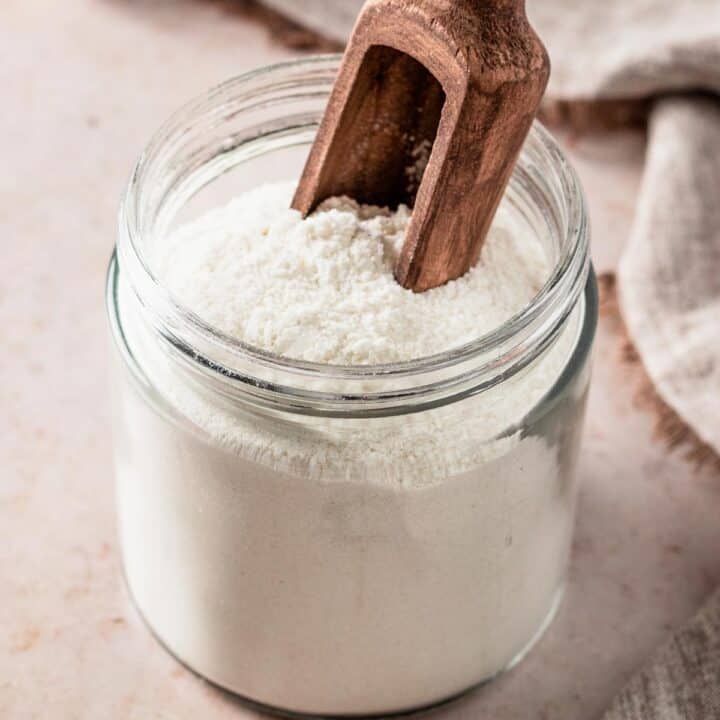Almond flour has grown in popularity over the years as the flour of choice for healthier baked treats or for recipes to cater to gluten sensitivities.
In this in-depth guide, you'll learn how almond flour is made, how to use it, how to store it, and valuable gluten-free baking tips and tricks.

Jump To
- What is Almond Flour
- How To Make Almond Flour
- How To Blanch Almonds
- Easy Method to Make Almond Flour
- Best Tips
- Baking With Almond Flour
- Recipes With Almond Flour
- How To Store Almond Flour
- Nutritional Benefits Of Almond Flour
- Almond Flour vs Almond Meal
- Ground Almonds vs Almond Flour
- Why Use Almond Flour
- Pros and Cons of Almond Flour
- FAQs
- You May Also Like
- Comments
What is Almond Flour
Almond flour consists of finely ground-blanched whole almonds. It has a slightly sweet and nutty taste and is used mostly as a grain-free alternative for gluten-sensitive people.
How To Make Almond Flour
The Types Of Almonds
Almonds can be bought blanched (peeled) or unpeeled, unsalted almonds or salted, raw or roasted, slivered, or sliced.
Raw, unsalted, blanched almonds are best type of almonds for making almond flour. Blanched almonds are usually more expensive than unblanched almonds due to the extra step involved in removing the almond skins.
What You’ll Need To Make Almond Flour
You only need one ingredient (almonds!), a blender or food processor, and a fine mesh sieve.
How To Blanch Almonds
Soak the whole almonds in freshly boiled water for 2 minutes. Pat them dry and remove the loose skin.
Toast the peeled almonds in a heated pan (on low heat) until they look moist-free (about 5 minutes).
Once dried, the blanched almonds can be blended to make the almond flour.
Easy Method to Make Almond Flour
- Add the blanched almonds to a high-speed blender and blitz on high for 5-10 seconds until a fine, powdery flour is achieved.
- Tap the blender and use a spatula to dislodge any flour mixture stuck to the sides of the blender.
- Blend again for 10-15 seconds.
If you like, you can also sift the homemade almond flour with a fine mesh sieve or fine mesh strainer to ensure you’re left with extra fine powder. Any larger pieces of almonds can then be crushed or blitzed before being shifted and added to the rest of the flour.
Best Tips
- Don’t blend the blanched almonds too much. If the mixture becomes sticky and paste-like, you’ve gone too far.
- Adjust the blending time of the almonds according to the strength of your particular blender or food processor.
- For ultra-fine almond flour, sift the flour through a fine or medium-mesh strainer and then blitz the larger remaining pieces.
- 1 ¼ cups of almond flour equals 1 cup of blanched almonds.

Baking With Almond Flour
- Binder: Since almond flour doesn’t contain gluten, the recipe must include certain binding agents, such as eggs, xanthan gum, guar gum, or psyllium husk.
- Baking time and temperature: Baked goods using almond flour tend to bake faster. Reduce the heat and the baking time.
- Less flour required: Less almond flour is required for every cup of regular flour. ⅓ cup of almond flour can be used for every 1 cup of regular flour for yeast baking (bread, rolls, pizza), and ¼ cup of almond flour can be used for every cup of regular white flour for non-yeast baking (cookies, scones, cake, biscuits, muffins).
- Cookies vs. cakes/breads: Almond flour can be used as the only flour in cookie recipes, but I recommend using a mixture of almond flour and other flour when making cakes and bread, as almond flour alone can result in dense cakes and bread.
- Cooling time: Always allow baked treats made with almond flour to cool completely before being transferred to a container or plate, as baked goods with almond flour tend to crumble easily.
- Measuring: Never pack almond flour when measuring it. It should be measured loosely in a measuring cup.
Recipes With Almond Flour
What can you make with almond flour? A ton of things! We use it for both sweet and savory recipes.
- Almond flour tortillas
- Pancakes
- Cookies - try peanut butter cookies, thumbprint jam cookies.
- Granolas
- Cakes
- As a coating for veggies like cauliflower and zucchini fries.
Try these readers' favorite recipes with almond flour:
How To Store Almond Flour
- Room temperature. Store homemade almond flour at room temperature (in a dark place) in a sealable jar or container for 2 weeks.
- Fridge. Store it in the fridge in an airtight container for up to 3 months for later use.
- Freezer. Store in the freezer for 6 months. When ready to use, measure the amount required and allow it to sit at room temperature for 15-20 minutes before using.
If you notice any green, white, or black spots it is an indication of spoilage. If almond flour has gone rancid, you'll be able to smell an unpleasant odor.
Nutritional Benefits Of Almond Flour
Almond flour has many health benefits. It is a great source of protein, healthy fats, dietary fiber, and other minerals, vitamins, and antioxidants. It’s particularly rich in vitamin E, calcium, phosphorus, magnesium, and copper.
Every cup provides 51 grams of fat, 20 grams of protein, 17 grams of carbohydrates, 3 grams of sugar, and 10 grams of fiber. It’s particularly low in carbs and sugar - perfect for those who wish to reduce their sugar and carbohydrate intake.

Almond Flour vs Almond Meal
Homemade almond meal is made from raw, unpeeled almonds, while almond flour is made from blanched (peeled) almonds.
Almond meal is coarser in texture with a slightly darker appearance from the ground almond peels, and it tends to have a stronger almond flavor, too.
Almond flour is finer, lighter, and more subtle in flavor - making it ideal for baking or adding to recipes where you don’t necessarily want the almond flavor to dominate.
Many use almond meal and almond flour interchangeably. It comes down to personal preference and experience to know what works best in a particular recipe.
Ground Almonds vs Almond Flour
Ground almonds with their skins on is almond meal, while almond flour is ground almonds that have first been “blanched” (peeled).
What you choose to use will depend on the texture, color, and flavor you prefer adding to your recipes when using one or the other.
Why Use Almond Flour
Homemade flour like almond flour is incredibly easy to make, always tastes fresher when made from scratch at home, and is usually more cost-effective than store-bought almond flour.
Pros and Cons of Almond Flour
If you’re unfamiliar with almond flour and aren’t sure whether to use it in your baking and cooking, this list of pros and cons may help you:
Pros:
- Gluten-free: Great gluten sensitivities or to eliminate wheat flour alternatives from diets.
- Keto-friendly: Low in net carbs and high in monounsaturated fats.
- Texture and flavor: Finer texture and a subtle nutty and sweet flavor. It won’t overpower the main flavors of any dish, unlike something like coconut flour.
- Nutritious: It’s packed with various vitamins, minerals, and antioxidants. It’s also a good source of dietary fiber!
Cons:
- Expensive: Can be more expensive in grocery stores compared to regular flour.
- Making from home: It’s easy to overblend the almonds into almond butter instead of flour. Extra caution must be applied.
- Not a 1-1 substitution: Almond flour is not a 1-1 substitution for all-purpose flour or other gluten-free flours.
- Higher absorption: Almond flour tends to absorb more liquid than regular flour.
- No Gluten for binding: You must ensure that a binding agent is added to the recipe, such as eggs.
FAQs
Yes, it is. Some brands contain flavor coatings with gluten, so it’s always best to check the labels.
Yes, but it will rise less than regular flour (whether gluten-based or gluten-free).
Yes! Remove excess moisture from the almond pulp by squeezing it through a cheesecloth and then spreading it on parchment paper on a baking tray and baking it at 180F for 2.5 hours, mixing it every 30 minutes. It should easily crumble between your fingers once dried.
Once dried, add the pulp to a blender and blitz for about 10 seconds.
Almond flour made from almond pulp is much thinner as the milking process strips most of the fat from the pulp. Recipes made with almond flour from almond pulp will likely be more dense and less moist.
Yes! Since almonds are permitted on a keto diet, almond flour is keto-friendly.
You May Also Like
I would appreciate it so much if you left a comment about this post below! Subscribe to join the TYB newsletter and receive free recipes straight to your inbox! Let's connect via Facebook, IG & Pinterest!
Note: Nutrition information is estimated and varies based on products used.
Full Nutrition Disclaimer can be found here.











Comments
No Comments